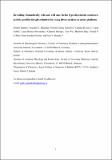| dc.contributor.author | Kaltner, Herbert | |
| dc.contributor.author | Manning, Joachim C. | |
| dc.contributor.author | García Caballero, Gabriel | |
| dc.contributor.author | Di Salvo, Claudia | |
| dc.contributor.author | Gabba, Adele | |
| dc.contributor.author | Romero-Hernández, Laura L. | |
| dc.contributor.author | Knospe, Clemens | |
| dc.contributor.author | Wu, Dan | |
| dc.contributor.author | Daly, Harrison C. | |
| dc.contributor.author | O'Shea, Donal F. | |
| dc.contributor.author | Gabius, Hans-Joachim | |
| dc.contributor.author | Murphy, Paul V. | |
| dc.date.accessioned | 2019-05-24T11:01:03Z | |
| dc.date.available | 2019-05-24T11:01:03Z | |
| dc.date.issued | 2018-08-14 | |
| dc.identifier.citation | Kaltner, Herbert, Manning, Joachim C., García Caballero, Gabriel, Di Salvo, Claudia, Gabba, Adele, Romero-Hernández, Laura L., Knospe, Clemens, Wu, Dan, Daly, Harrison C., O'Shea, Donal F., Gabius, Hans-Joachim, Murphy, Paul V. (2018). Revealing biomedically relevant cell and lectin type-dependent structure–activity profiles for glycoclusters by using tissue sections as an assay platform. RSC Advances, 8(50), 28716-28735. doi: 10.1039/C8RA05382K | en_IE |
| dc.identifier.issn | 2046-2069 | |
| dc.identifier.uri | http://hdl.handle.net/10379/15194 | |
| dc.description.abstract | The increasing realization of the involvement of lectin-glycan recognition in (patho)physiological processes inspires envisioning therapeutic intervention by high-avidity/specificity blocking reagents. Synthetic glycoclusters are proving to have potential for becoming such inhibitors but the commonly used assays have their drawbacks to predict in vivo efficacy. They do not represent the natural complexity of (i) cell types and (ii) spatial and structural complexity of glycoconjugate representation. Moreover, testing lectins in mixtures, as present in situ, remains a major challenge, giving direction to this work. Using a toolbox with four lectins and six bi- to tetravalent glycoclusters bearing the cognate sugar in a model study, we here document the efficient and versatile application of tissue sections (from murine jejunum as the model) as a platform for routine and systematic glycocluster testing without commonly encountered limitations. The nature of glycocluster structure, especially core and valency, and of protein features, i.e. architecture, fine-specificity and valency, are shown to have an influence, as cell types can differ in response profiles. Proceeding from light microscopy to monitoring by fluorescence microscopy enables grading of glycocluster activity on individual lectins tested in mixtures. This work provides a robust tool for testing glycoclusters prior to considering in vivo experiments. | en_IE |
| dc.description.sponsorship | Inspiring discussions with Drs B. Friday and A. Leddoz are gratefully acknowledged. Research in this paper was funded in part by Science Foundation Ireland (Grant Number 12/IA/1398) and the Irish Research Council (Grant Number GOIPG/2016/858). L. L. R.-H. thanks CONACYT-México (Grant 290936) for financial support. | en_IE |
| dc.format | application/pdf | en_IE |
| dc.language.iso | en | en_IE |
| dc.publisher | Royal Society of Chemistry | en_IE |
| dc.relation.ispartof | RSC Adv. | en |
| dc.rights | Attribution-NonCommercial-NoDerivs 3.0 Ireland | |
| dc.rights.uri | https://creativecommons.org/licenses/by-nc-nd/3.0/ie/ | |
| dc.subject | adhesion | en_IE |
| dc.subject | agglutinin | en_IE |
| dc.subject | glycoconjugate | en_IE |
| dc.subject | glycosides | en_IE |
| dc.subject | histochemistry | en_IE |
| dc.subject | targeting | en_IE |
| dc.title | Revealing biomedically relevant cell and lectin type-dependent structure–activity profiles for glycoclusters by using tissue sections as an assay platform | en_IE |
| dc.type | Article | en_IE |
| dc.date.updated | 2019-05-23T14:10:57Z | |
| dc.identifier.doi | 10.1039/C8RA05382K | |
| dc.local.publishedsource | https://dx.doi.org/10.1039/C8RA05382K | en_IE |
| dc.description.peer-reviewed | peer-reviewed | |
| dc.contributor.funder | Science Foundation Ireland | en_IE |
| dc.contributor.funder | Irish Research Council | en_IE |
| dc.contributor.funder | CONACYT-México | en_IE |
| dc.internal.rssid | 16255765 | |
| dc.local.contact | Paul Murphy, School Of Chemistry, Room 108, Arts/Science Building, Nui Galway. 2465 Email: paul.v.murphy@nuigalway.ie | |
| dc.local.copyrightchecked | Yes | |
| dc.local.version | SUBMITTED | |
| dcterms.project | info:eu-repo/grantAgreement/SFI/SFI Investigator Programme/12/IA/1398/IE/Glycoside & glycoconjugate synthesis through development and application of chelation induced anomerization/ | en_IE |
| nui.item.downloads | 244 | |


